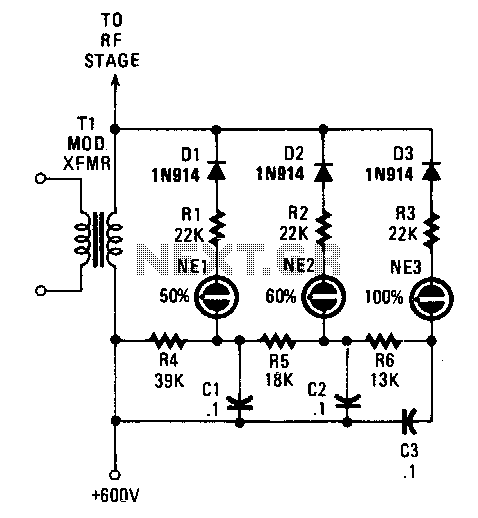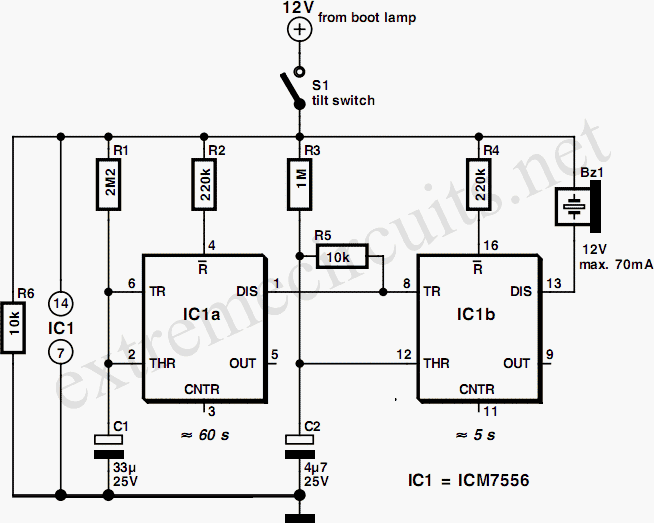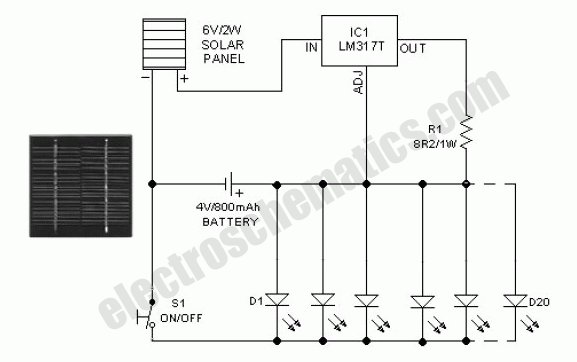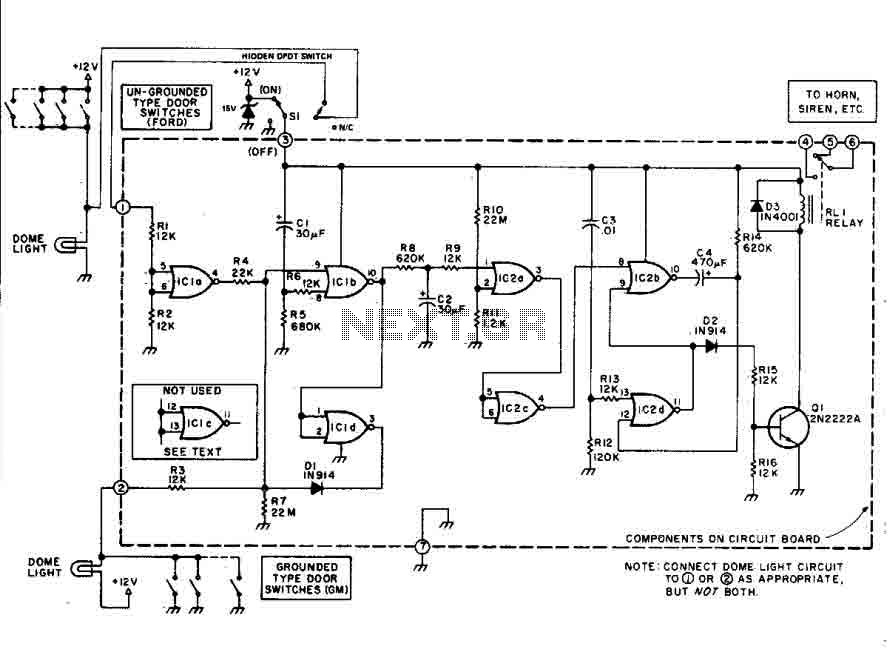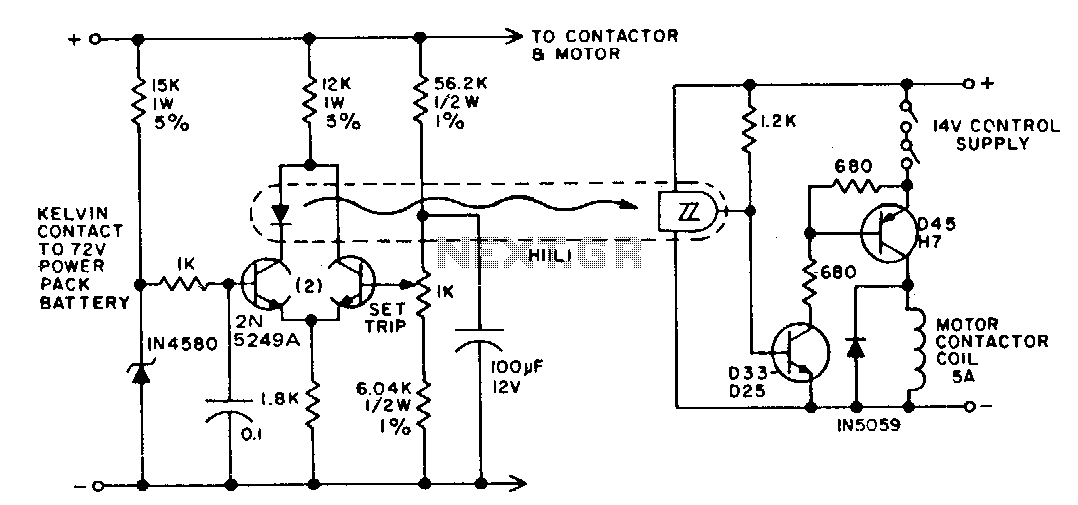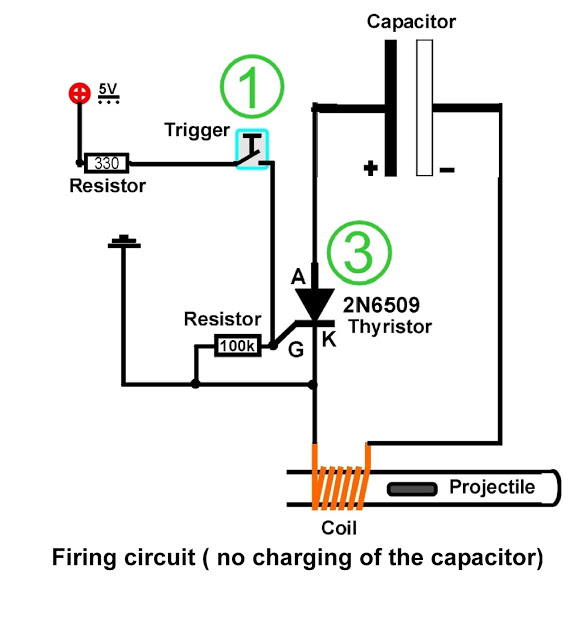
car battery monitor with 3 led
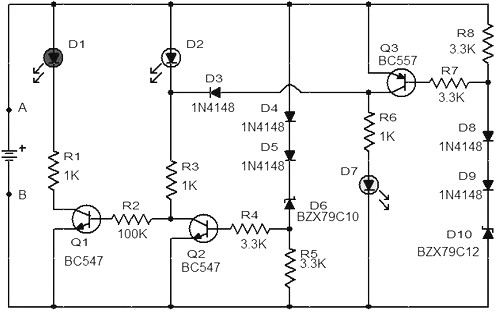
When the battery voltage is 11.5V or lower, transistor Q1 is activated, causing LED D1 to illuminate. If the battery voltage is between 11.5V and 13.5V, transistor Q2 is activated, resulting in LED D2 lighting up. At a battery voltage of 13.5V, transistor Q3 is turned on, which lights up LED D3. The schematic diagram is derived from the circuit: Car Battery Monitor with a 3 LED power supply. Additional information can be found on the corresponding page regarding the power supply related to this circuit diagram.
The circuit functions as a battery voltage monitoring system using three transistors and three LEDs to provide visual indications of the battery's voltage level.
Transistor Q1, configured as a low-side switch, is responsible for monitoring the battery voltage when it falls below 11.5V. In this state, Q1 conducts, allowing current to flow through LED D1, which lights up to indicate a low battery condition. This feature serves as an early warning for users to recharge or replace the battery.
Transistor Q2 is activated when the battery voltage is between 11.5V and 13.5V. In this range, Q2 operates similarly to Q1 but is designed to indicate a nominal battery voltage. When Q2 turns on, LED D2 illuminates, providing a visual cue that the battery is within an acceptable voltage range. This helps users understand that the battery is functioning properly without immediate attention required.
At a voltage of 13.5V, transistor Q3 is engaged, activating LED D3. This indicates that the battery is fully charged or operating at a healthy voltage level. The use of three distinct LEDs allows for quick visual assessment of the battery's state, enabling users to take appropriate actions based on the battery's condition.
The schematic diagram for this circuit typically includes the three transistors, each connected to their respective LEDs, along with resistors to limit current and protect the components. The circuit may also include a voltage divider or reference voltage source to accurately monitor the battery voltage levels. Overall, this design is effective for simple battery monitoring applications, providing clear visual feedback for battery status.When the battery voltage is 11. 5V or less transistor Q1 is turned on and the LED D1 will be bright. When the battery voltage is between 11. 5 and 13. 5 V, the transistor Q2 is turned on and the LED D2 will light up. When the battery voltage is 13. 5V transistor Q3 will be on the D3 and the LED will light. The schematic diagram come from circuit: Car Battery Monitor with 3 LED power supply. Go to that page to read the explanation about above power supply related circuit diagram. 🔗 External reference
The circuit functions as a battery voltage monitoring system using three transistors and three LEDs to provide visual indications of the battery's voltage level.
Transistor Q1, configured as a low-side switch, is responsible for monitoring the battery voltage when it falls below 11.5V. In this state, Q1 conducts, allowing current to flow through LED D1, which lights up to indicate a low battery condition. This feature serves as an early warning for users to recharge or replace the battery.
Transistor Q2 is activated when the battery voltage is between 11.5V and 13.5V. In this range, Q2 operates similarly to Q1 but is designed to indicate a nominal battery voltage. When Q2 turns on, LED D2 illuminates, providing a visual cue that the battery is within an acceptable voltage range. This helps users understand that the battery is functioning properly without immediate attention required.
At a voltage of 13.5V, transistor Q3 is engaged, activating LED D3. This indicates that the battery is fully charged or operating at a healthy voltage level. The use of three distinct LEDs allows for quick visual assessment of the battery's state, enabling users to take appropriate actions based on the battery's condition.
The schematic diagram for this circuit typically includes the three transistors, each connected to their respective LEDs, along with resistors to limit current and protect the components. The circuit may also include a voltage divider or reference voltage source to accurately monitor the battery voltage levels. Overall, this design is effective for simple battery monitoring applications, providing clear visual feedback for battery status.When the battery voltage is 11. 5V or less transistor Q1 is turned on and the LED D1 will be bright. When the battery voltage is between 11. 5 and 13. 5 V, the transistor Q2 is turned on and the LED D2 will light up. When the battery voltage is 13. 5V transistor Q3 will be on the D3 and the LED will light. The schematic diagram come from circuit: Car Battery Monitor with 3 LED power supply. Go to that page to read the explanation about above power supply related circuit diagram. 🔗 External reference
